This tip was provided by:
Calvin Trostle, Extension Agronomy, Lubbock, 806-746-6101, ctrostle@ag.tamu.edu
Statewide
Albino Striping in Grain Sorghum Leaves—Glyphosate Drift?
Herbicide drift is an issue in Texas cropping that sometimes we don’t want to talk about. I often find that producers don’t want to stir things up with neighbors and their herbicide applicators, be it land or by air, but the downside is that sometimes crops are indeed injured and yields drop. Lest anyone blame any particular crop, this is a two-way street. The sorghum producer is worried about glyphosate drift from the neighbor’s cotton field, but then cotton farmer is worried about sorghum’s possible use and mistakes in applying 2,4-D or dicamba, for which the cotton farmer’s crop can be injured. Introduce additional issues like conventional non-Roundup Ready cotton, high-value organic production (no chemical pesticides at all), and now the forthcoming dicamba and 2,4-D tolerant cottons, and drift issues can compound and become quite touchy.
In the Texas High Plains in 2014 due to some early rains and the broad distribution of Palmer ameranth species of pigweed, a lot of Roundup drift was observed onto grain sorghum. Early symptoms were often a nearly complete purple discoloration (Fig. 1) followed by various levels of tissue discoloration as some plants died (Fig. 2). Common to many of these seedlings is that secondary root growth from the base of the small crown was minimal to none (Fig. 3). These plants never recovered even with various foliar treatments with nutrients and growth regulators. The sooner they were replanted the better.
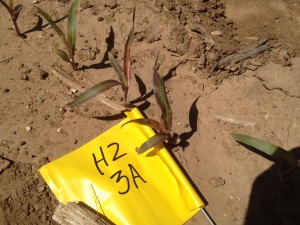
Fig. 1. Early purplish symptoms of glyphosate drift on seedling grain sorghum, Floyd Co., TX (2014).
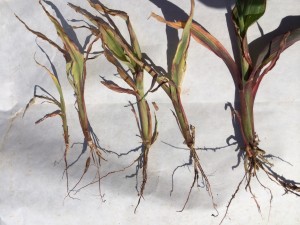
Fig. 2. Range of glyphosate drift symptoms on grain sorghum seedlings, Crosby Co., TX (2014). None of these plants would resume normal growth if they do survive.
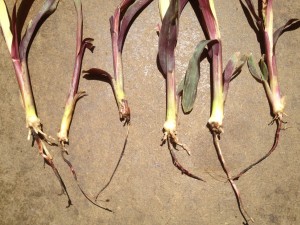
Fig. 3. Lack of secondary root development from the base of the crown due to glyphosate drift on grain sorghum seedlings, Hale Co., TX (2014). These seedlings would not recover.
Other plants might have exhibited light stunting, but overall survival was not in question. What did eventually show up a few weeks after the apparent glyphosate drift was albino or white striping on lower leaves, usually leaves 3 to 8, depending on the field and its growth stage at the time of drift (Fig. 4, Fig. 5). Dr. Wayne Keeling, Texas A&M AgriLife Research weed scientist, Lubbock, was able to reproduce these symptoms using dilute glyphosate in a hand spray bottle.
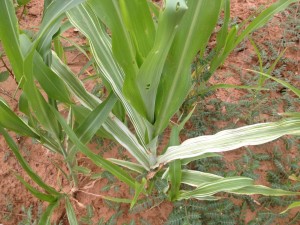
Fig. 4. Light glyphosate drift which led to eventual white striping symptoms on lower grain sorghum leaves, Hale Co., TX (2014). Plant withstood light drift without long-term injury and headed normally.
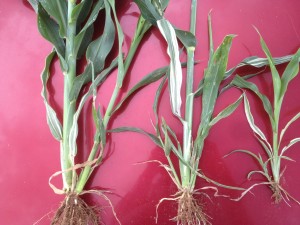
Fig. 5. Range of grain sorghum plant growth after receiving light injury from glyphosate drift (Lubbock Co., 2014). Left to right, plants demonstrated decreased ability to grow out of injury and head normally.
Similar drift symptoms of glyphosate injury on grain sorghum also appeared in the South Plains region in 2015. Some fields had spotty damage (Fig. 6) whereas others received enough drift to permanently stunt or kill most plants (Fig. 7).
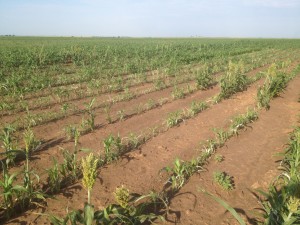
Fig. 6. Moderate to severe glyphosate drift from aerial application in sporadic pattern across a grain sorghum field, Lynn Co., TX (2015). Albino striping is evident on plants in center, and contrast of growth is observed from damaged vs. undamaged.
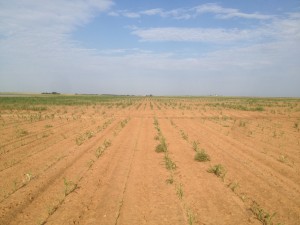
Fig. 7. Catastrophic glyphosate drift injury on grain sorghum from aerial application which occurred approximately ¾ mile away, Lynn Co., TX (2015).
Through many observations, particularly in 2014, it was interesting to see how often a barrier to drift might protect grain sorghum such as the rows of sorghum that received protection from 6-7’ tall corn plants (Fig. 8.). Fencerows, weeds (24” or taller), and even terrace ridges were enough to protect several rows of grain sorghum from significant injury.
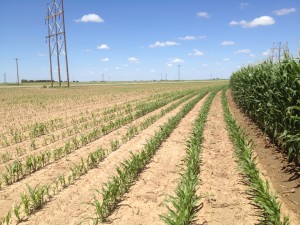
Fig. 8. Several rows of grain sorghum protected by irrigated corn from apparent glyphosate drift from a southeast wind, Hale Co., TX (2014).
One producer has shared that the albino symptoms also can express in sorghum that was sprayed with glyphosate as a harvest aid. In this Rolling Plains example, the producer achieved a poor desiccation and kill with the glyphosate, and the plants regrew after harvest and stalks were baled. Albino symptoms were strongly evident on the regrowth (Fig. 9).
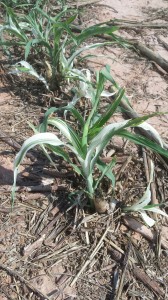
Fig. 9. Glyphosate harvest aid application to grain sorghum, August, 2015, Wilbarger Co., TX, resulted in poor desiccation and sorghum plants survived. After stalks were cut and baled for hay, sorghum regrowth in September demonstrated significant white leaf striping from residual in-plant glyphosate effects.
Much of the problems we have observed in the High Plains probably also occur in grain sorghum at some level in other Texas regions. Communication with neighbors before spraying—then holding people accountable if drift injury occurs—will help ensure needed safety and caution to minimize future drift injury potential.
Are there other possible factors that cause white sorghum?
Yes. Dr. Tom Isakeit, AgriLife Extension plant pathologist, College Station, notes that sorghum downy mildew is known to produce similar albino striping in leaves. There are four potential downy mildew inducing pathogens (one causes ‘crazy top’), but only Peronosclerospora sorghi in more advanced stages leads to white interveinal (between the veins) striping of the leaves (Fig. 10). This disease more likely develops under cool, humid weather and initial symptoms are a surface white powder on the leaves (mildew), but later stages of disease development lead to emerging leaves exhibiting parallel green and white stripes. The white tissue eventually becomes black (dies) and shreds.
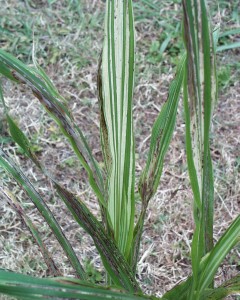
Fig. 10. Sorghum downy mildew and white striping in grain sorghum. Some white tissue is dying (now black, speckled). (File photo courtesy Dr. Tom Isakeit, AgriLife Extension plant pathology, College Station, TX.)
Also, clomazone herbicide (common brand is Command) may cause some striping in rotational crops like grain sorghum if residues remain after the 9-month rotation restriction. This herbicide has been used in cotton, rice, sugarcane, soybeans, and some beans, peas and vegetables in the past, but Dr. Keeling is aware of only little if any remaining Command use in Texas.








